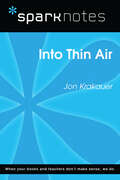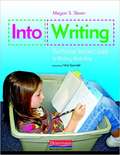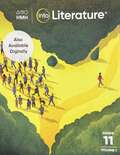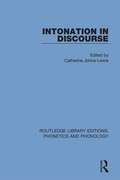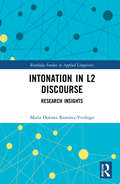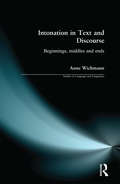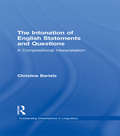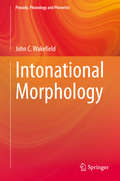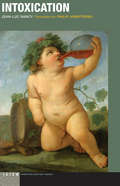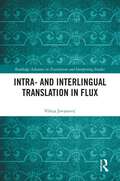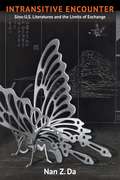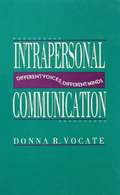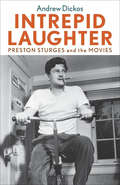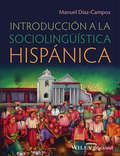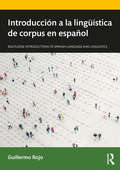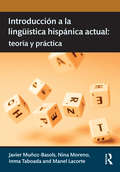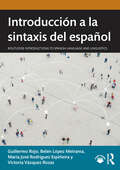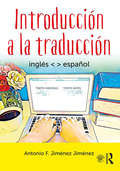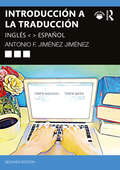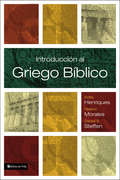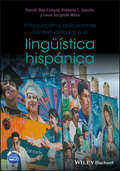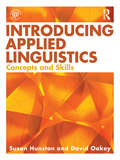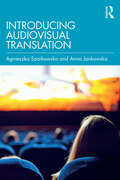- Table View
- List View
Into Thin Air (SparkNotes Literature Guide Series)
by SparkNotesInto Thin Air (SparkNotes Literature Guide) by John Krakauer Making the reading experience fun! Created by Harvard students for students everywhere, SparkNotes is a new breed of study guide: smarter, better, faster. Geared to what today's students need to know, SparkNotes provides: *Chapter-by-chapter analysis *Explanations of key themes, motifs, and symbols *A review quiz and essay topicsLively and accessible, these guides are perfect for late-night studying and writing papers
Into Writing: The Primary Teacher's Guide to Writing Workshop
by Megan Sloan<p>"I want to set up a writing workshop in my classroom-now what?" <p>"What should my teaching look like day to day?" <p>"What about minilessons? Conferences and assessment? Share time?" <p>These are just a few of the many questions about writing workshop that teacher and nationally known staff developer Megan Sloan has been asked. With Into Writing this workshop veteran sets out to answer these and the other most commonly asked questions about teaching writing well.</p>
Intonation and Prosodic Structure (Key Topics in Phonology)
by Caroline FéryThis book provides a state-of-the-art survey of intonation and prosodic structure. Taking a phonological perspective, it shows how morpho-syntactic constituents are mapped to prosodic constituents according to well-formedness conditions. Using a tone-sequence model of intonation, it explores individual tones and how they combine, and discusses how information structure affects intonation in several ways, showing tones and melodies to be 'meaningful' in that they add a pragmatic component to what is being said. The author also shows how despite a superficial similarity, languages differ in how their tonal patterns arise from tone concatenation. Lexical tones, stress, phrase tones, and boundary tones are assigned differently in different languages, resulting in great variation in intonational grammar, both at the lexical and sentential level. The last chapter is dedicated to experimental studies of how we process prosody. The book will be of interest to advanced students and researchers in linguistics, and particularly in phonological theory. Provides a broad overview of mainstream generative approaches in intonation and prosodic structure. Covers a large number of languages and facilitates a comparison of their tonal and prosodic systems. Provides in-depth analyses of the interfaces between intonation and prosodic structure, and also of syntax and semantics.
Intonation in Discourse (Routledge Library Editions: Phonetics and Phonology #11)
by Catherine Johns-LewisFirst published in 1986. This book presents studies of intonation undertaken from within a number of different traditions: acoustic phonetics, phonology, psychology, social psychology, syntax, conversation analysis, developmental phonetics and sociolinguistics. The studies reported are empirically based, and give an indication of the many methodologies which have been developed in different disciplines for the investigation of the nature, structure and functions of intonation.
Intonation in L2 Discourse: Research Insights (Routledge Studies in Applied Linguistics)
by María Dolores Ramírez-VerdugoGrounded in a systemic functional linguistic (SFL) approach, this book applies a contrastive interlanguage corpus-based approach to investigate the nature and role of L2 intonation and its pragmatic function in spoken discourse. The volume offers a brief overview of SFL theories and frameworks, with a clear focus on Halliday’s model of phonology and the proposal of developing a grammar of speech. Integrating a SFL framework with a corpus linguistic-informed approach, the book uses this foundation as a jumping-off point from which to explore the prosodic complexities involved in English language teaching and learning for L2 learners, highlighting its various functions as illustrated in examples from the UAM English Learner Spoken Corpus. A final chapter synthesizes these findings toward critically reflecting on future directions for the study of L2 speech prosody. This book will be key reading for graduate students and researchers in applied linguistics and English language teaching.
Intonation in Text and Discourse: Beginnings, Middles and Ends (Studies in Language and Linguistics)
by Anne WichmannIt is clear that a printed text provides the reader with more information than the words alone. This includes punctuation marks, capitalisation, paragraphs, headings and sub-headings, all of which help the reader to understand how the words are organised into sentences, and sentences are organised into a coherent text. In a spoken text, this typographical information is necessarily absent. So how do readers and speakers provide equivalent information to the listener?Intonation in Text and Discourse describes the way in which speech melody, or intonation, is used to signal the structure of spoken texts. It examines the role of intonation in clarifying the relationship between successive utterances, from close cohesive ties ('middles') to major breaks for a new topic ('ends' and 'beginnings').The book is concerned chiefly with the intonational structuring of read or prepared monologue, but also devotes a chapter to current developments in the analysis of intonation in conversation. It describes not only how intonation is used to organise systematic turn-taking but also how it can signal greater or lesser degrees of co-operativeness. It addresses finally the complex issue of attitudinal intonation - the elusive 'tone of voice'.The first book on discourse intonation to deal with such a wide variety of naturally-occurring spoken data, Intonation in Text and Discourse will be of great interest to students, lecturers and researchers of intonation and all aspects of spoken discourse.
The Intonation of English Statements and Questions: A Compositional Interpretation (Outstanding Dissertations in Linguistics)
by Christine BartelsEnglish sentence prosody provides cues to both focus structure and speaker attitude. Taking the phonological model of intonation developed by Pierrehumbert (1880 et seq.) as point of departure, this work illuminates the communicative function of English pitch contours by (1) giving a detailed survey of phrase-final contours found in statements and questions, and (2) investigating what attitudinal features determine choice of phrasal tones in these utterance types. This comprehensive study will be of interest to linguists in a number of fields, ranging from prosody to semantics, pragmatics, and discourse analysis.
Intonational Morphology (Prosody, Phonology and Phonetics)
by John C. WakefieldThis book discusses the morphological properties of intonation, building on past research to support the long-recognized relationship between the functions and meanings of discourse particles and the functions and meanings of intonation. The morphological status of intonation has been debated for decades, and this book provides evidence from the literature combined with new and compelling empirical evidence to show that specific intonational forms correspond to specific segmental discourse particles. Based on the conclusion that intonation is in the lexicon, it proposes syntactic positions for intonational meanings using a cartographic approach. It also describes how intonation is represented in speakers' minds, which has important implications for first and second language acquisition as well as for theories and approaches to artificial speech recognition and production. This book is of interest to theoretical and applied linguists, as well as to anyone whose research and interests relate in any way to intonation.
Intoxication (Idiom: Inventing Writing Theory)
by Jean-Luc NancyFrom Plato’s Symposium to Hegel’s truth as a “Bacchanalian revel,” from the Bacchae of Euripedes to Nietzsche, philosophy holds a deeply ambivalent relation to the pleasures of intoxication. At the same time, from Baudelaire to Lowry, from Proust to Dostoyevsky, literature and poetry are also haunted by scenes of intoxication, as if philosophy and literature share a theme that announces and navigates their proximities and differences.For Nancy, intoxication constitutes an excess that both fascinates and questions philosophy’s sober ambitions for appropriate forms of philosophical behavior and conceptual lucidity. At the same time, intoxication displaces a number of established dualities—reason and passion, mind and body, rationality and desire, rigor and excess, clarity and confusion, logic and eros.Taking its point of departure from Baudelaire’s categorical imperative to understand modernity—“be drunk always”—Nancy’s little book is composed in fragments, quotations, drunken asides, and inebriated repetitions. His contemporary “banquet” addresses a range of related themes, including the role of alcohol and intoxication in rituals, myths, divine sacrifice, and religious symbolism, all those toasts to the sacred “spirits” involving libations and different forms of speech and enunciation—to the gods, to modernity, to the Absolute. Affecting both mind and body, Nancy’s subject becomes intoxicated: Ego sum, ego existo ebrius—I am, I exist—drunk.
Intra- and Interlingual Translation in Flux (Routledge Advances in Translation and Interpreting Studies)
by Višnja JovanovićThis book extends new lines of inquiry on intra- and interlingual translation, building on Jakobson’s classification of translational relations to take into account the full complexity of language and the role of social dimensions in fostering linguistic unity and identity. Jovanović argues that intra- and interlingual translation do not form a stable relationship but, in fact, are both contingent on how languages and their borders are defined. Chapters unpack the causes and effects of this instability through the lens of Serbo- Croatian literature, where the impact of sociopolitical pressure on language over time can be keenly observed. Drawing on work from translation studies, sociolinguistics, close reading, distant reading, and discourse analysis, Jovanović charts how linguistic fluidity, where linguistic borders are challenged at both the macro and the micro level as a result of sociopolitical change, in turns shapes literary and cultural circulation. In its examination of the intersection of the linguistic and social in translational relations in the Serbo- Croatian context, the book can offer wider insights into better understanding the literary and translational landscape of analogous sociolinguistic and geographic milieus. This volume will be of interest to scholars in literary translation, translation theory, sociology of translation, comparative literature, and multilingualism.
Intransitive Encounter: Sino-U.S. Literatures and the Limits of Exchange
by Nan DaWhy should the earliest literary encounters between China and the United States—and their critical interpretation—matter now? How can they help us describe cultural exchanges in which nothing substantial is exchanged, at least not in ways that can easily be tracked? All sorts of literary meetings took place between China and the United States in the nineteenth and early twentieth centuries, involving an unlikely array of figures including canonical Americans such as Washington Irving, Ralph Waldo Emerson, and Henry Wadsworth Longfellow; Chinese writers Qiu Jin and Dong Xun; and Asian American writers like Yung Wing and Edith Eaton. Yet present-day interpretations of these interactions often read too much into their significance or mistake their nature—missing their particularities or limits in the quest to find evidence of cosmopolitanism or transnational hybridity.In Intransitive Encounter, Nan Z. Da carefully re-creates these transpacific interactions, plying literary and social theory to highlight their various expressions of indifference toward synthesis, interpollination, and convergence. Da proposes that interpretation trained on such recessive moments and minimal adjustments can light a path for Sino-U.S. relations going forward—offering neither a geopolitical showdown nor a celebration of hybridity but the possibility of self-contained cross-cultural encounters that do not have to confess to the fact of their having taken place. Intransitive Encounter is an unconventional and theoretically rich reflection on how we ought to interpret global interactions and imaginings that do not fit the patterns proclaimed by contemporary literary studies.
Intrapersonal Communication: Different Voices, Different Minds (Routledge Communication Series)
by Donna R. VocateIntrapersonal communication is a relatively new phenomenon for communication study and still lacks the grounding of a sound theoretical base. The first to present a developed theory of this discipline, this book's goal is to provide graduate students and professionals with an organized point of departure for their research. The theoretical section begins with an intrapersonal communication theory derived from the sociogenetic views of George Herbert Mead and L.S. Vygotsky. This theory emphasizes social interaction, the developmental nature of mind, and the crucial role of speech in creating a self, a culture, and a mind which then interact in human intrapersonal communication. This section also provides the reader with a coherent interdisciplinary knowledge base taken from speech communication, biology, neurology, cultural psychology, anthropology, sociology, speech pathology, and linguistics. The integrated theoretical perspective that results makes the study compatible with communication scholarship focusing on the social, cultural, cognitive, or performance aspects of communication phenomena. The applications section examines neurophysiological/intrapersonal communication research methods and studies to date, together with specific applications of intrapersonal communication theory to childhood language acquisition, to the establishment of gender identities, and to intrapersonal competence. The final chapter presents pedagogical guidance on how we can influence intrapersonal competence and performance as well as commenting on the current state of this study and its future prospects. The editor's interstitial commentary facilitates access by readers wishing to constuct their own theory.
Intrepid Laughter: Preston Sturges and the Movies (Screen Classics)
by Andrew DickosThe life and career of the pioneering writer-director whose name is synonymous with sophisticated screwball comedies.Preston Sturges was known for bringing sophistication and wit to the genre of comedy, establishing himself as one of the most valuable writer-directors in 1940s Hollywood. Today, more than a half century after they were originally produced, his films have lost little of their edge and remain extremely popular.Intrepid Laughter is an essential guide to the life and work of this luminary of the stage and screen, following Sturges from his unusual childhood, to his early success as a Broadway playwright, to his whirlwind career in Hollywood.
Intro to English 101
by Pearson Learning SolutionsWelcome to English 100, where our goal is clear: to help you master the writing skills you need to succeed in your college courses.
Introduccin a la sociolingüstica hispnica
by Manuel Diaz-CamposIntroducción a la Sociolingüística Hispánica es un libro de texto imprescindible para los estudiantes de pregrado que cursan sociolingüística hispánica. Cada capítulo está redactado en un lenguaje sencillo y accesible. Sobre la base de un enfoque pedagógico, cada capítulo incluye una introducción, una lista de los temas a ser discutidos, el desarrollo de tales temas, un resumen, una lista de términos claves, un glosario de la terminología clave, una sección de ejercicios y preguntas de comprensión al final de cada sección temática de cada capítulo.Provee una introducción actualizada sobre los temas más relevantes de la versátil sociolingüística española contemporánea tales como la variación fonológica, el bilingüismo, la lengua y las leyes, las actitudes lingüísticas, entre otrosIncluye una variedad de actividades para apoyar y extender el aprendizaje de los estudiantesOfrece un enfoque pedagógico único que incluye ejercicios de análisis de datos. Estas actividades estimulan la investigación por parte de los estudiantes a través del uso de las bases de datos, la música popular y otros recursos audiovisualesEl libro incluye ejemplos de las variedades de español habladas en el mundo hispanohablante con secciones especiales dedicadas a las variedades habladas en los EEUU Introducción a la Sociolingüística Hispánica is a much-needed undergraduate introduction to the study of sociolinguistics in the Spanish-speaking world. Written in accessible Spanish, each chapter includes an overview, a review of topics, a section of key terms, exercises and questions.Provides up-to-date coverage of the main topics of sociolinguistics - such as phonological variation, bilingualism, and language attitudes - in relation to the Hispanic worldIncorporates a variety of activities to support and extend student's learningOffers a unique pedagogical approach, in which data analysis exercises encourage students to conduct research by using electronic databases, popular music, and audiovisual materialFeatures examples that apply to Spanish varieties spoken around the world, with special sections dedicated to the Spanish varieties of the US
Introducción a la lingüística de corpus en español
by Guillermo RojoIntroducción a la lingüística de corpus en español es la primera obra concebida desde la óptica del español para investigar los corpus textuales existentes en la actualidad. Destinada a conjugar armónicamente la exposición de cuestiones teóricas y metodológicas, proporciona información detallada sobre las tareas necesarias en el diseño, construcción y explotación de un corpus a partir de numerosos ejemplos de obtención de datos sobre diferentes cuestiones léxicas y gramaticales. Características principales: • Exposición de cuestiones teóricas y metodológicas combinada con el tratamiento de casos prácticos de extracción y análisis de datos procedentes de corpus textuales de español; • Análisis de fenómenos léxicos y gramaticales del español desde diferentes perspectivas y con atención a la variabilidad diacrónica, diatópica y diastrática; • Indicación detallada del modo de obtener los datos necesarios para la investigación en diferentes corpus del español; • Inclusión de un resumen inicial, actividades de investigación en cada capítulo y lecturas complementarias recomendadas; • Presentación de un capítulo final con herramientas informáticas útiles para el análisis de textos no incluidos en corpus textuales; • Recopilación de los principales términos usados en la lingüística de corpus en un glosario bilingüe (español e inglés). Introducción a la lingüística de corpus en español es una obra con un enfoque marcadamente didáctico, y dirigida fundamentalmente a estudiantes avanzados de grado y posgrado, profesores que necesiten hacer uso de corpus en sus clases, investigadores que precisen un conocimiento más profundo de la lingüística de corpus o expertos en otras disciplinas que deseen familiarizarse con una perspectiva técnica de los fenómenos lingüísticos.
Introducción a la lingüística hispánica actual: teoría y práctica
by Javier Muñoz-Basols Manel Lacorte Nina Moreno Taboada InmaIntroducción a la lingüística hispánica actual is the ideal introduction to Spanish linguistics for all undergraduate and postgraduate students of Spanish. No prior knowledge of linguistics is assumed as the book takes you step-by-step through all the main subfields of linguistics, both theoretical and applied. Phonology. morphology, syntax, semantics, pragmatics, second language acquisition, history of the Spanish language, dialectology and sociolinguistics are concisely and accurately outlined providing a comprehensive foundation in the field. A comprehensive companion website provides a wealth of additional resources including further exercises to reinforce the material covered in the book, extra examples to clarify the most difficult concepts, extensive audio clips which reproduce the sounds of phonemes and allophones and sonograms. Written in a clear and accessible manner with extensive auxiliary materials, Introducción a la lingüística hispánica actual has been specially designed for students of Spanish with little or no linguistic background who need to understand the key concepts and constructs of Spanish linguistics.
Introducción a la sintaxis del español (Routledge Introductions to Spanish Language and Linguistics)
by null Guillermo Rojo null Belén López Meirama null María José Rodríguez Espiñeira null Victoria Vázquez RozasLa Introducción a la sintaxis del español proporciona una panorámica general de la sintaxis del español. El libro analiza el uso y la variación interna para presentar las estructuras sintácticas en el marco de una consideración funcionalista de la lengua como un sistema dinámico y variable.La obra aborda conceptos generales de sintaxis, la estructura de la cláusula, fenómenos clausales de particular importancia, la combinación de cláusulas y las características básicas de las frases. Cada uno de los dieciocho capítulos desarrolla un tema concreto, incluye ejemplos y ejercicios destinados a consolidar el conocimiento de los estudiantes y sugiere lecturas que permiten profundizar en las cuestiones tratadas. Los elementos y fenómenos analizados son ilustrados con ejemplos procedentes de diferentes variedades del español contemporáneo extraídos de corpus escritos y orales. El libro combina la visión general de los principios de la aproximación funcionalista con el análisis de los aspectos que presentan mayor interés y resultan de mayor utilidad didáctica en los niveles introductorios.Dirigida a estudiantes de lengua española y lingüística, la Introducción a la sintaxis del español constituye una introducción innovadora y accesible a la sintaxis española para estudiantes de español como lengua extranjera y hablantes nativos.El libro tiene una página de apoyo con las soluciones a los ejercicios de cada capítulo en www.routledge.com /9781032438467.------------------------------------------------------------------------------------------------------------------------------------------------------Introducción a la sintaxis del español provides a panoramic introduction to the study of Spanish syntax. Taking a functionalist approach, the book considers usage and language-internal variation to present syntactic structure within the context of language as an inherently dynamic and variable system.The book addresses general concepts of syntax, the structure of the clause, clause phenomena of particular importance, the combination of clauses and the basic characteristics of phrases. Each of the eighteen chapters develops a specific topic and provides a wealth of examples and exercises to cement students’ knowledge as well as offering guidance for further reading. The elements and phenomena analysed are illustrated with examples from all the current varieties of Spanish, taken from corpora and the spoken language. The book combines a comprehensive overview of the general principles of a functionalist approach to language with an analysis of the syntactic aspects that are the most interesting and didactically useful at the introductory level.Aimed at students of Spanish language and linguistics, Introducción a la sintaxis del español offers an innovative and user-friendly introduction to the topic of Spanish syntax for students of Spanish as a foreign language and native speakers.The author’s website for the book which includes further exercises and answer keys is accessible via www.routledge.com/9781032438467.
Introducción a la traducción: inglés - español
by Antonio F Jiménez JiménezEste manual introduce al lector a la actividad de la traducción de inglés a español y viceversa, adoptando un punto de vista práctico y siguiendo los estándares profesionales actuales.? Introducción a la traducción examina una gran variedad de temas enfocados en resolver los problemas de traducción que se suelen encontrar en los textos, por ejemplo, en relación a los elementos culturales, los aspectos connotativos, la variación lingüística, la traducción subordinada y la traducción especializada. Para ello, se exploran detenidamente, y con multitud de ejemplos prácticos, las técnicas, estrategias y herramientas disponibles durante la actividad traductora. La página web que acompaña a este manual incluye además información lingüística contrastiva entre el inglés y el español para evitar problemas de transferencia negativa entre ambos idiomas.? Introducción a la traducción aumentará la competencia traductora de los lectores de una manera sistemática, coherente y contextualizada, ofreciendo oportunidades de práctica a través de un gran número de actividades y textos para traducir.? ? This manual introduces readers to the activity of Spanish-English/English-Spanish translation while adopting a practical perspective aligned with current professional standards.? Introducción a la traducción examines a wide variety of topics that focus on resolving common problems that tend to arise throughout the process of translating different kinds of texts. For example, this book explores translation issues with respect to cultural elements, connotative meaning, linguistic variations, constrained translation and specialized translation. It offers a multitude of practical examples and a thorough consideration of the techniques, strategies and tools available to translators. Among other resources, the companion website includes contrastive linguistic analysis of English and Spanish to help avoid negative transfer issues between both languages.? Introducción a la traducción will improve the reader’s competence as a translator in a systematic, coherent and contextualized way, providing abundant opportunities to practice translation skills through ample hands-on activities and a wide variety of texts to translate.
Introducción a la traducción: inglés < > español
by Antonio F. Jiménez JiménezAhora en su segunda edición, este manual introduce al lector a la actividad de la traducción de español-inglés/inglés-español, adoptando un punto de vista práctico y siguiendo los estándares profesionales actuales. Integrando los últimos avances en la profesión de la traducción con sólidos enfoques pedagógicos, Introducción a la traducción explora las competencias necesarias durante el proceso de traducción; desde el conocimiento de las lenguas y las culturas hasta la comprensión de la traducción como actividad y como producto, a través de una diversidad de tipos textuales. Cada lección cuenta con una gran cantidad de actividades y ejercicios prácticos. Esta nueva edición ofrece más actividades, más ejemplos que reflejan las variedades de español de Latinoamérica, contenidos ampliados y nuevos temas de actual relevancia, como la interpretación a distancia, la localización, la traducción automática y la inteligencia artificial. Los estudiantes aumentarán su competencia traductora de una manera sistemática, relevante y contextualizada. En esta segunda edición, se han aumentado los recursos disponibles en la página web del manual, incluyendo nuevas presentaciones de PowerPoint y herramientas de evaluación para los instructores, así como más textos para la práctica de la traducción para los estudiantes. Now in its second edition, this manual introduces readers to the activity of Spanish-English/English-Spanish translation, while adopting a practical perspective aligned with current professional standards. Integrating the latest developments in the translation profession with solid pedagogical approaches, Introducción a la traducción explores the competencies needed during the translation process; from knowledge about the languages and cultures, to understanding translation as an activity and as a product through a diversity of text types. Each lesson provides ample practice through hands-on activities and exercises. This new edition offers more activities, more examples relevant to Latin American varieties of Spanish, expanded content, and coverage of contemporary topics, such as remote interpreting, localization, machine translation, and artificial intelligence. Students will increase their translation competency in a systematic, meaningful, and contextualized way. In this second edition, the companion website provides additional resources, including new PowerPoint presentations and assessment tools for instructors, and more texts for translation practice for students.
Introducción al griego bíblico
by Anita Henriques Daniel S. Steffen Nelson MoralesLa obra «Introducción al griego bíblico» responde a una fuerte necesidad sentida por todos los que han tenido la responsabilidad de formar a los futuros líderes de las iglesias. También entre los que ya son ministros se ha sentido durante mucho tiempo la necesidad de conocer con mayor precisión y profundidad los textos del Nuevo Testamento en su idioma original, el griego común o koiné. En un exitoso intento por llenar esta laguna, Ann Henriques, Nelson Morales y Daniel S. Steffen, Profesores del Seminario Teológico Centroamericano en Ciudad Guatemala, han preparado esta obra introductoria que responde con claridad y sencillez a las preguntas de siempre entre los que saben que necesitan conocer el idioma original de esta parte de las Escrituras, y al mismo tiempo no saben cómo lograrlo: ¿Dónde y cuándo se originó el idioma griego? ¿Por qué es importante estudiarlo? ¿Cuáles son las dificultades a superar en el estudio de un idioma que ni siquiera utiliza el mismo alfabeto que nosotros? ¿Cuál es la manera más práctica de estudiarlo? Los autores van resolviendo todos estos interrogantes, uno por uno. Desde el alfabeto griego hasta las declinaciones de las palabras y la conjugación de los verbos, todo es explicado de una manera asequible a quienes realmente se quieran familiarizar con este idioma. Dicho en pocas palabras, los profesores de uno de los seminarios teológicos más respetados de Iberoamérica han trabajado en equipo para presentarnos hoy esta «Introducción al griego bíblico», que muy pronto será reconocida como el mejor curso introductorio para el estudio del griego bíblico.
Introducción y aplicaciones contextualizadas a la lingüística hispánica
by Kimberly L. Geeslin Manuel Diaz-Campos Laura Gurzynski-WeissIntroducción y aplicaciones contextualizadas a la lingüística hispánica provides a contemporary introduction to the study of Spanish, helping students apply linguistics analysis to the study of language. It encourages the reader to analyze language in action and understand how linguistic components interact to convey conceptual and social meaning. A contemporary introduction to the study of Spanish that encourages both Spanish and semi-proficient non-native Spanish speaking students to see language in action and understand how linguistic components interact to convey conceptual and social meaning Addresses the core sub-fields of linguistics (phonetics, phonology, morphology, syntax, semantics, and pragmatics) as they relate to the study of the Spanish language Uses second language acquisition as a foundation upon which linguistic analysis can be built Supplementary companion website includes exercises, comprehension questions, cutting-edge research highlights, lists of key terms, and analytical mini-projects designed to help the user and encourage students to apply learned theoretical knowledge to real-world language use contexts Instructors will also have access to a sample 16-week semester syllabus and corresponding task-based lesson plans (in PowerPoint format) as well as assignments which they can edit for use in their own learning context.
Introducing Applied Linguistics: Concepts and Skills
by Susan Hunston David OakeyIntroducing Applied Linguisticsprovides in-depth coverage of key areas in the subject, as well as introducing the essential study skills needed for academic success in the field. Introducing Applied Linguistics: * is organised into two Sections: the first introducing Key Concepts in Applied Linguistics; and the second devoted to the Study Skills students need to succeed. * features specially commissioned chapters from key authorities who address core areas of Applied Linguistics, including both traditional and more cutting edge topics, such as: grammar, vocabulary, language in the media, forensic linguistics, and much more. * contains a study skills section offering guidance on a range of skills, such as: how to structure and organise an essay, the conventions of referencing, how to design research projects, plus many more. * is supported by a lively Companion Website, which includes interactive exercises, information about the contributors and why they've written the book, and annotated weblinks to help facilitate further independent learning. Ideal for advanced undergraduate and postgraduate students of Applied Linguistics and TEFL/TESOL, Introducing Applied Linguisticsnot only presents selected key concepts in depth, but also initiates the student into the discourse of Applied Linguistics. Susan Hunstonis Professor of English Language and Head of the School of English, Drama, and American & Canadian Studies, at the University of Birmingham, UK. David Oakeyis an Assistant Professor in the Applied Linguistics Program at Iowa State University, USA. Contributing authors: Svenja Adolphs, Aileen Bloomer, Zoltán Dörnyei, Adrian Holliday, Alison Johnson, Chris Kennedy, Almut Koester, Ruby Macksoud, Kirsten Malmkjaer, Kieran O'Halloran, David Oakey. Juup Stelma, Joan Swann, Geoff Thompson, Dave Willis, Jane Willis and David Woolls.
Introducing Audiovisual Translation
by Agnieszka Szarkowska Anna JankowskaThis user-friendly textbook offers comprehensive insights into all facets of audiovisual translation and media localisation.Serving as a comprehensive guide spanning seven chapters, it begins by introducing audiovisual translation (AVT). It goes on to explore the historical backdrop and highlights the distinctions from traditional written text translation. The authors expertly navigate you through the primary AVT modalities: interlingual subtitling, dubbing, voice-over, subtitling for the deaf and hard of hearing, live subtitling, and audio description.A blend of theoretical concepts and practical, real-world examples in various languages ensures a seamless understanding of the fundamental principles of AVT. The book clearly guides you through the most important aspects of each type of AVT.Designed for those exploring various AVT forms, budding audiovisual translators, and those interested in contemporary AVT trends and research, this book is an invaluable resource for students of translation and linguistics and for educators in AVT across higher education and media localisation programmes.
